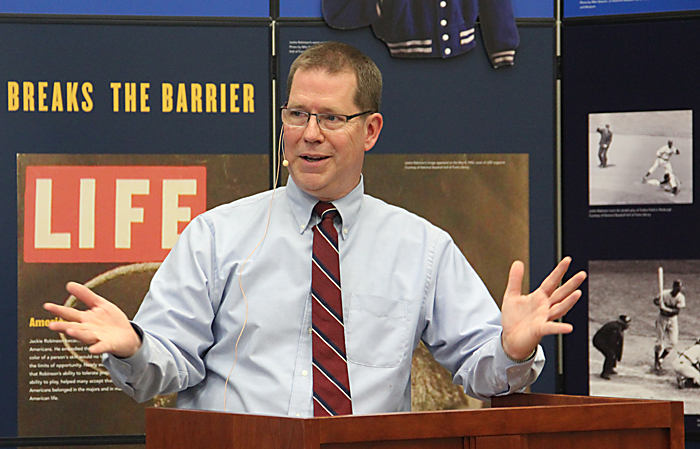- Jeremy Krock,
Founder of the "Negro Leagues Baseball Grave Marker Project"
 |
Jeremy Krock, founder of the "Negro Leagues Baseball Grave Marker Project," speaking to students at Milner Library. (Photo by Daneisha Goodman / Staff Photographer) |
Jeremy Krock stumbled upon his passion in 2003 when he started marking unmarked graves of Negro League Baseball players. Since then Krock, a Peoria anesthesiologist, has now marked over 25 graves throughout the United States.
Krock spoke about his project, “The Negro Leagues Baseball Grave Marker Project,” Thursday, April 19 at Milner Library to help promote “Pride and Passion: The African-American Baseball Experience,” a traveling exhibit now on display at ISU’s Milner Library.
Krock’s interest in the project began with a family tradition on Memorial Day of honoring the graves of lost family members by putting flowers on each gravestone. This sparked an interest in Krock to find the gravestone of his town’s beloved baseball player, William “Jimmie” Crutchfield.
Crutchfield was a famed Negro Leagues outfielder who played in three East-West All Star Games. Crutchfield held a special place in Krock’s heart because he was from Krock’s hometime of Ardmore, Mo.
Crutchfield’s grave was tracked to Burr Oak Cemetery in Ardmore, where it was in fact unmarked. Krock began to write letters to the Negro Leagues Baseball Committee about wanting to put a proper gravestone on Crutchfield’s resting place.
Media exposure through such entities as the Chicago Tribune, Sports Illustrated, NBC and many more, led to the discovery of dozens of more graves from Negro Leagues baseball players who needed to be honored and properly marked.
Only after Krock got involved did he realize how many other unmarked graves were out there. “I would hate for them to be buried unmarked forever, so that is why we do what we do,” Krock says.
The marked graves stretch all over the United States including Springdale, Peoria, Oakwoods, Chicago, Greenwood, Pittsburgh and Clifton, New Jersey. Tracking the grave sites of the players is not always a walk in the park; it ensures a lot of obituary research, investigation of photographs and GPS coordinates.
Once the team gets past finding the actual resting place of the player, the marker costs from $600 to 2,000 plus instillation costs.
As Krock says, “There are many parts of the puzzle we struggle with, and a lot of challenges we face.”
Krock still continues to investigate unmarked graves of the Negro Leagues Baseball players and hopes he will inspire others to get involved.
“Hopefully someday down the road, someone will walk past a marker and get interested in Negro Leagues Baseball players,” he says.
The Negro Leagues Baseball Grave Marker Project is now a full-fledged charitable organization. For more information visit nlbgmp.com .